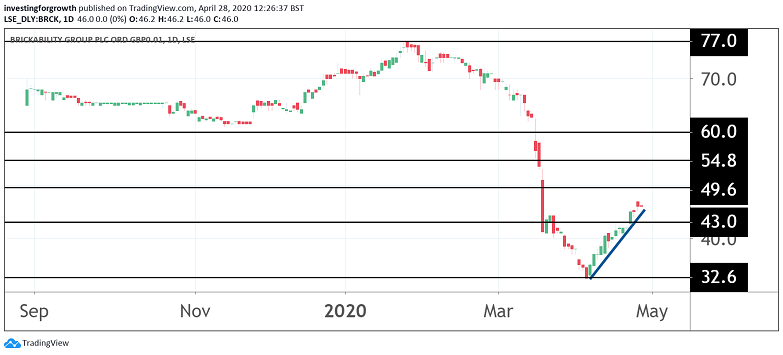Stockwatch: a share with real investment value
Is this small-cap’s 29% discount to flotation price worth exploiting? Our companies analyst thinks so.
28th April 2020 12:40
by Edmond Jackson from interactive investor
Is this small-cap’s 29% discount to flotation price worth exploiting? Our companies analyst thinks so.

Can the world now slowly emerge from the worst of lockdown? Markets have sustained a positive global view despite Britain officially being hunkered down. Yet there are already signs of movement in housebuilding and construction, Taylor Wimpey (LSE:TW.) leading the way by opening most of its building sites from next Monday. And I already notice small-scale domestic builders and their whining devices resuming action.
Amidst this, a director of a subsidiary of AIM-listed Brickability Group (LSE:BRCK), a leading UK supplier of bricks and other materials, has snapped up £100,000 worth of shares at 46p. The company remains rather below the radar, floated last August by Cenkos Securities at 65p when Promethean, the private equity financier of a 2016 management buyout, cut its stake then exited entirely last February.
I wouldn’t read this as an automatic negative, given private equity’s modus operandi can be to reinvest in new situations rather than retain publicly listed equity stakes. The crux is whether it makes long-run economic sense to agglomerate various building materials’ supply within a listed plc, or whether this will just be the latest example of boosting earnings per share (EPS) and bonuses by going on the acquisition trail.
A cynical investing view would be that, so long as the sector is attractive, the game plan makes strategic sense and there are enough decent targets for a parent company to evolve from modest beginnings, then capital growth will ensue. The story at flotation entertained raising underlying profit of £14.3 million on £140 million revenue, to £500 million revenue over the next five years.
Indeed, if construction is one of the early industries to resume activity and, given the government’s longer-term objective to support house-building, it is worth being aware of plc’s taking shape.
Five acquisitions made since flotation
Raising about £54 million net (and diluting equity by 38%), the proceeds went chiefly to cut debt but also to augment a war chest – the end-September 2019 interim balance sheet showing long-term debt down from £58 million to £20 million, near-term debt quite similar at £5.5 million and cash up from £10.3 million to £18.1 million.
There are broadly three divisions of materials supply: bricks; heating, plumbing and joinery; and roofing such as tiles and ancillary products. Recent purchases have been: DSH Flooring, Bespoke Brick (whose director bought stock), LBT Facades, Brickmongers and U Plastics, a merchant for facia, soffits, guttering, external cladding and related items.
U Plastics, bought for £6 million in March, is a 16-year-old business making £1.3 million profit on £8 million revenue last year, operating in the South East. That sounds decent acquisition criteria, although one wants to read more by way of economic rationale and benefits for agglomerating what now appears to be 20 companies.
The broad goal is to “raise the company’s profile as the pre-eminent supplier of construction materials to the UK housebuilding industry” – versus two chief rivals of similar size, as of last August.
There is also competition from brick manufacturers when housebuilders occasionally buy direct, such that Brickability has recently had a circa 12% market share. Improved efficiencies in the supply chain are promised too.
- Why Omega Diagnostics shares are up 700% in April
- 12 coronavirus stocks: another AIM share rallies 90%
- These 32 stocks are ‘clear winners’ from the corona crisis
- Take control of your retirement planning with our award-winning, low-cost Self-Invested Personal Pension (SIPP)
Management says the majority of items distributed are made in the UK, although bricks, windows and doors are imported from EU countries and towel radiators from Turkey. That’s a high proportion from the EU given the interim results showed 57% of EBITDA, or adjusted operating profit, deriving from bricks.
For example, Bespoke Brick imports from Europe, though is the sole UK supplier of certain products. Brickability says it has distribution plans for whatever form Brexit may take.
Things had looked pretty good until late March
A trading update cited business in line with expectations, if citing EBITDA – the profit figure on which acquirers typical focus – in line with full-year expectations.
In fairness, the last (interim) income statement did show some variables after EBITDA and before operating profit, e.g. £1 million exceptional income, £0.5 million flotation costs and £0.3 million debt refinancing costs.
So, as yet, it is a reasonable normalised measure.
The context has been recent consensus for a 58% rise in net profit to £14.4 million for the latest financial year, with EPS impacted by the flotation-placing to 6.2p and paying out a 2.3p dividend.
So, with the stock at around 46p currently, the price/earnings (PE) ratio is 7.4x and yield about 5%. Some would say that a £106 million company is going to be valued more attractively in uncertain times for higher risk.

Source: TradingView Past performance is not a guide to future performance
Ratings compare with £18 billion CRH (LSE:CRH) on 12x prospective earnings with a 3.2% yield; £1.3 billion Marshalls (LSE:MSLH) on 22x earnings and a 2.75% yield; and £1 billion Polypipe (LSE:PLP) on 17x earnings and a 2.5% yield.
However, Brickability’s near-9% operating margin is below 10% for CRH, 13.6% for Marshalls and 15% for Polypipe – as if management needs to show it can exact synergies from its acquisitive development.
The outlook is guesswork now that the company has “closed its sites, with staff able to work from home continuing to support customers and suppliers”. That sounds merely a hand-holding effort until “it is possible and responsible to resume delivery schedules.”
Implicitly then, the Bespoke Brick boss takes the view, this cannot last a lot longer and, though it could take until next year to get near pre-Covid-19 levels of turnover, the stock’s 29% discount to its flotation price represents investment value. If Brickability can manage through this crisis and deliver on its five-year plan, he’s probably right.
| Brickability Group - financial summary | ||
|---|---|---|
| Year end 31 Mar | 2018 | 2019 |
| Turnover (£ million) | 11.7 | 163 |
| Operating margin (%) | 1.1 | 8.6 |
| Operating profit (£m) | 0.1 | 14.1 |
| Net profit (£m) | -0.3 | 7.5 |
| EPS - reported (p) | -0.1 | 3.3 |
| EPS - normalised (p) | -0.1 | 3.2 |
| Price/earnings ratio (x) | 14.4 | |
| Operating cashflow/share (p) | 0.3 | 8.2 |
| Capital expenditure/share (p) | 0.6 | 0.5 |
| Free cashflow/share (p) | -0.4 | 7.7 |
| Cash (£m) | 5.4 | 17.0 |
| Net debt (£m) | 65.2 | 50.7 |
| Net assets (£m) | 8.1 | 17.4 |
| Net assets per share (p) | 3.5 | 7.6 |
| Source: company accounts |
Cash had risen to £22 million as of 25 March
All discretionary spend had been ceased, there were low levels of stock, and conserving cash would be a priority. Earlier this year, a new £35 million revolving credit facility was put in place, of which £10 million remained undrawn.
But in line with the vast majority of listed companies, guidance for the financial year ahead was withdrawn, so you make your own guess as to likely damage in the current financial year.
More positively, the circumstances ought to favour a reasonably cash-rich, potential acquirer of small private firms, although the challenge to determine “fair price” could also mean deals get deferred, notwithstanding forced sales in the event of a second Covid-19 wave.
Mind how intangibles constitute 95% of net assets
The 30 September 2019 (interim) balance sheet had £74.8 million of intangibles relative to £78.9 million net assets. I expect this largely reflects acquisitions made at a premium to tangible book value.
Also note that £39.6 million trade receivables slightly outweighed trade payables over the prior 12 months, and it is unclear quite how the ratio will pan out – probably with attendant risk from debtors.
- The Ian Cowie portfolio: how I would access this technology boom
- Dividend poll: find out where investors are turning for income
- A checklist for finding dividend shares in a crisis
The cashflow statement showed £8.9 million absorbed by trade payables, the chief reason net cash from operations eased from £8.8 million to £2.2 million, although interest paid also rose from £0.5 million to £3.6 million.
This first set of results post-flotation was effectively a bedding-down, where disciplined investors would insist on a lengthier plc track record. Yet the current environment ought to be opportune to accumulate equity in a developing supplier to an industry earmarked for continued government support.
The chief uncertainty is timing, and Brickability needs to prove economies and raise its margin, then its stock rating too. So, it is a relatively speculative stock, but one which looks well-established in its industry, with development potential. Averaging in could work for those appreciating the risks. Buy.
Edmond Jackson is a freelance contributor and not a direct employee of interactive investor.
These articles are provided for information purposes only. Occasionally, an opinion about whether to buy or sell a specific investment may be provided by third parties. The content is not intended to be a personal recommendation to buy or sell any financial instrument or product, or to adopt any investment strategy as it is not provided based on an assessment of your investing knowledge and experience, your financial situation or your investment objectives. The value of your investments, and the income derived from them, may go down as well as up. You may not get back all the money that you invest. The investments referred to in this article may not be suitable for all investors, and if in doubt, an investor should seek advice from a qualified investment adviser.
Full performance can be found on the company or index summary page on the interactive investor website. Simply click on the company's or index name highlighted in the article.
Disclosure
We use a combination of fundamental and technical analysis in forming our view as to the valuation and prospects of an investment. Where relevant we have set out those particular matters we think are important in the above article, but further detail can be found here.
Please note that our article on this investment should not be considered to be a regular publication.
Details of all recommendations issued by ii during the previous 12-month period can be found here.
ii adheres to a strict code of conduct. Contributors may hold shares or have other interests in companies included in these portfolios, which could create a conflict of interests. Contributors intending to write about any financial instruments in which they have an interest are required to disclose such interest to ii and in the article itself. ii will at all times consider whether such interest impairs the objectivity of the recommendation.
In addition, individuals involved in the production of investment articles are subject to a personal account dealing restriction, which prevents them from placing a transaction in the specified instrument(s) for a period before and for five working days after such publication. This is to avoid personal interests conflicting with the interests of the recipients of those investment articles.